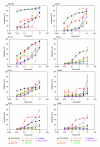Signatures of drug sensitivity in nonsmall cell lung cancer
- PMID: 22091388
- PMCID: PMC3200133
- DOI: 10.1155/2011/215496
Signatures of drug sensitivity in nonsmall cell lung cancer
Abstract
We profiled receptor tyrosine kinase pathway activation and key gene mutations in eight human lung tumor cell lines and 50 human lung tumor tissue samples to define molecular pathways. A panel of eight kinase inhibitors was used to determine whether blocking pathway activation affected the tumor cell growth. The HER1 pathway in HER1 mutant cell lines HCC827 and H1975 were found to be highly activated and sensitive to HER1 inhibition. H1993 is a c-MET amplified cell line showing c-MET and HER1 pathway activation and responsiveness to c-MET inhibitor treatment. IGF-1R pathway activated H358 and A549 cells are sensitive to IGF-1R inhibition. The downstream PI3K inhibitor, BEZ-235, effectively inhibited tumor cell growth in most of the cell lines tested, except the H1993 and H1650 cells, while the MEK inhibitor PD-325901 was effective in blocking the growth of KRAS mutated cell line H1734 but not H358, A549 and H460. Hierarchical clustering of primary tumor samples with the corresponding tumor cell lines based on their pathway signatures revealed similar profiles for HER1, c-MET and IGF-1R pathway activation and predict potential treatment options for the primary tumors based on the tumor cell lines response to the panel of kinase inhibitors.
Figures






References
-
- Jemal A, Bray F, Center MM, Ferlay J, Ward E, Forman D. Global cancer statistics. CA Cancer Journal for Clinicians. 2011;61:69–90. - PubMed
-
- Vaporciyan AA, Nesbitt JC, Lee JS, et al. Holland-Frei Cancer Medicine. 5th edition. BC Decker; 2000.
-
- Roggli VL, Vollmer RT, Greenberg SD, McGavran MH, Spjut HJ, Yesner R. Lung cancer heterogeneity: a blinded and randomized study of 100 consecutive cases. Human Pathology. 1985;16(6):569–579. - PubMed
-
- Schiller JH, Harrington D, Belani CP, et al. Comparison of four chemotherapy regimens for advanced non-small-cell lung cancer. The New England Journal of Medicine. 2002;346(2):92–98. - PubMed
-
- Comis RL. The current situation: erlotinib (Tarceva) and gefitinib (Iressa) in non-small cell lung cancer. The Oncologist. 2005;10(7):467–470. - PubMed
LinkOut - more resources
Full Text Sources
Other Literature Sources
Research Materials
Miscellaneous
